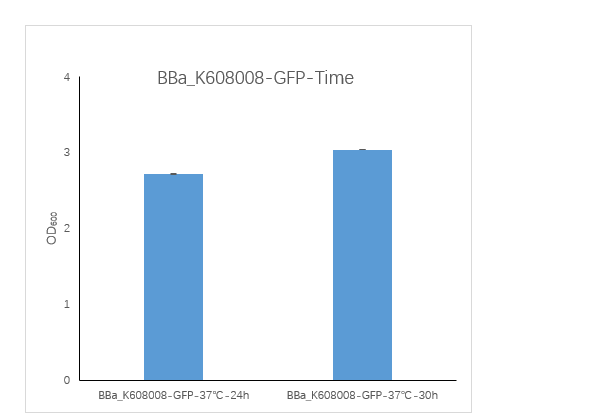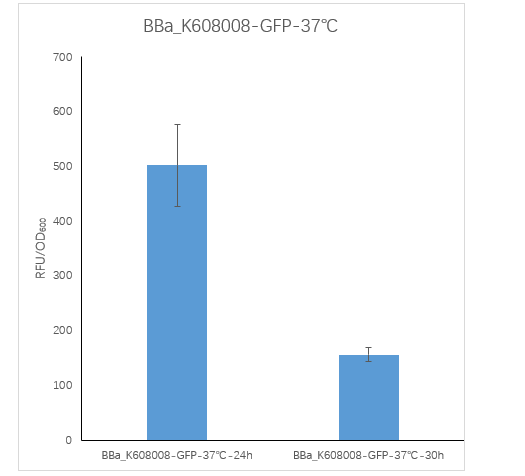Difference between revisions of "Part:BBa K608008"
Night12138 (Talk | contribs) m (Add Tongji_China's works. -- committed by Night12138) |
|||
| Line 81: | Line 81: | ||
|0.8579 | |0.8579 | ||
|} | |} | ||
| + | |||
| + | ==Xiamen_City 2019's characterization== | ||
| + | ===BBa_K608008 constitutive strong promoter with medium RBS and GFP=== | ||
| + | |||
| + | <p>The number of cells in the medium changes with the culture time. We studied this phenomenon by experimenting with changes in culture time.</p> | ||
| + | <p>1. We transformed the plasmid contanining BBa_K608008 into bacterial competent cells, plated and cultured overnight at 37 °C. </p> | ||
| + | <p>2. On the evening of the next day, we picked a single clone into a tube containing 5 ml LB which is called 0h. We culture bacterial cells at 37 ° C, 220 rpm. The sampling time points are 24h and 30h. </p> | ||
| + | <p>3. We took 100ul of the bacteria culture and measured the total fluorescence with a Thermo fluorescence microplate reader. We took 200ul of the ten-fold diluted bacterial solution and measured the OD600 with BioTek optical microplate reader. Total fluorescence is divided by OD600 to obtain fluorescence value per OD600.</p> | ||
| + | [[Image:K608008-S1.png|400px|Characterization of popular BioBrick RBSs]] | ||
| + | |||
| + | <strong>Figure1. BBa_K608008 containing strain OD600 at 24h and 30h.</strong> | ||
| + | <p>We measured the OD600 of the strain at 24h and 30h, respectively. The OD600 at 24h is 2.725 ,which is slightly lower than the OD600 3.04 at 30h.</p> | ||
| + | [[Image:K608008-S2.png|400px|Characterization of popular BioBrick RBSs]] | ||
| + | |||
| + | <strong>Figure2. BBa_K608008 containing strain Fluorescence per OD600 at 24h and 30h.</strong> | ||
| + | <p>We measured the RFU/OD600 of the strain at 24h and 30h, respectively. The RFU/OD600 at 24h is 501.76 ,which is significantly higher than the RFU/OD600 155.59 at 30h. </p> | ||
| + | |||
| + | <p>These results indicate that the bacterial strain in the medium reached the stationary phase at 24h and 30h.</p> | ||
| + | <p>The cell death rate is close to or even higher than the cell division rate, and the cell number remains stable for a certain time and then decreases.. The protein in the cell will only degrade, but will not be newly expressed, resulting in a decrease in protein levels.</p> | ||
Revision as of 08:10, 20 October 2019
constitutive strong promoter with medium RBS and GFP
Strong promoter from the constitutive promoter family combined with medium RBS (PR2) for strong gene expression. To quantify the gene expression, GFP was tagged to the promoter and RBS domain.
The GFP fluorescence was measured with a plate reader:
The fluorescence intensity and protein concentration were measured with the FLUOstar Omega,
which is a multi-mode microplate reader.
Samples were pipetted into the microplate and analyzed via the plate reader. In this experiment we focused on the protein concentration and the fluorescence intensity of RFP.
We measured the protein concentration with the bradford-assay. This is a method to determine the total protein concentration. To analyze the protein concentration of the samples, Coomassie Brillant Blue was pippeted to each sample. With the binding of the dye to the proteins the color changes from dark red to blue. The more protein in the solution the more Coomassie dye can bind to proteins and the more the color changes into blue. The absorption of bound Coomassie dye is 595nm. The absorbance is proportional with the amount of bound dye. With a series of Bovine Serum Albumin (BSA) measurements the exact protein concentration of the samples can be determined. BSA acts like a “marker” because the concentration of BSA is known and with a linear calibration line the exact protein concentration can be detected.
GFP served as a reporter of expression. We wanted to know how strong the promoter and RBS activity is. With this reporter gene it was possible to analyze the expression via plate reader. GFP is excited at a wavelength of 509nm and has an emission of 520nm. The plate reader illuminates the samples with a high energy xenon flash lamp. Optical filters or monochromator create the exact wavelength. The more GFP in the sample the higher is the GFP fluorescence intensity. The intensity is collected with the second optical system and is detected with a side window photomultiplier tube.
Promoter and RBS:
PR1: strong Promoter (J23104) strong RBS (B0034)
PR2: strong Promoter (J23104) medium RBS (B0032)
PR3: strong Promoter (J23104) weak RBS (B0031)
PR4: medium Promoter (J23110) strong RBS (B0034)
PR5: medium Promoter (J23110) medium RBS (B0032)
PR6: medium Promoter (J23110) weak RBS (B0031)
| sample | PR2 | PR3 | PR4 | PR5 | PR6 |
| GFP fluorescence intensity | 11378.5 | 1445.0 | 4596.2 | 41221.1 | 26922.7 |
| factor | 7.9 | 1.0 | 3.2 | 28.5 | 18.6 |
The results of this test show that PR2 is 7.9 times stronger than PR3, which has the lowest expression. The fluorescence intensity of GFP varies, and because of lack of time we could not repeat this experiment. We have also tested the promoter and RBS activity with RFP as a reporter and the results deviate from this experiment. So we are looking forward to test this system another time.
Tongji_China 2019 Characterization
| Sample | PR2(BBa_K608008) | PR5(BBa_K608011) | PR6(BBa_K608012) |
| GFP Fluorescence Intensity | 24541.23 | 62923.91 | 41902.30 |
| Fluorescence Intensity Factor | 1.0 | 2.6 | 1.7 |
| Positive Rate | 0.7563 | 0.9190 | 0.8579 |
Xiamen_City 2019's characterization
BBa_K608008 constitutive strong promoter with medium RBS and GFP
The number of cells in the medium changes with the culture time. We studied this phenomenon by experimenting with changes in culture time.
1. We transformed the plasmid contanining BBa_K608008 into bacterial competent cells, plated and cultured overnight at 37 °C.
2. On the evening of the next day, we picked a single clone into a tube containing 5 ml LB which is called 0h. We culture bacterial cells at 37 ° C, 220 rpm. The sampling time points are 24h and 30h.
3. We took 100ul of the bacteria culture and measured the total fluorescence with a Thermo fluorescence microplate reader. We took 200ul of the ten-fold diluted bacterial solution and measured the OD600 with BioTek optical microplate reader. Total fluorescence is divided by OD600 to obtain fluorescence value per OD600.
Figure1. BBa_K608008 containing strain OD600 at 24h and 30h.
We measured the OD600 of the strain at 24h and 30h, respectively. The OD600 at 24h is 2.725 ,which is slightly lower than the OD600 3.04 at 30h.
Figure2. BBa_K608008 containing strain Fluorescence per OD600 at 24h and 30h.
We measured the RFU/OD600 of the strain at 24h and 30h, respectively. The RFU/OD600 at 24h is 501.76 ,which is significantly higher than the RFU/OD600 155.59 at 30h.
These results indicate that the bacterial strain in the medium reached the stationary phase at 24h and 30h.
The cell death rate is close to or even higher than the cell division rate, and the cell number remains stable for a certain time and then decreases.. The protein in the cell will only degrade, but will not be newly expressed, resulting in a decrease in protein levels.
Sequence and Features
- 10COMPATIBLE WITH RFC[10]
- 12INCOMPATIBLE WITH RFC[12]Illegal NheI site found at 7
Illegal NheI site found at 30 - 21COMPATIBLE WITH RFC[21]
- 23COMPATIBLE WITH RFC[23]
- 25COMPATIBLE WITH RFC[25]
- 1000INCOMPATIBLE WITH RFC[1000]Illegal BsaI.rc site found at 706






